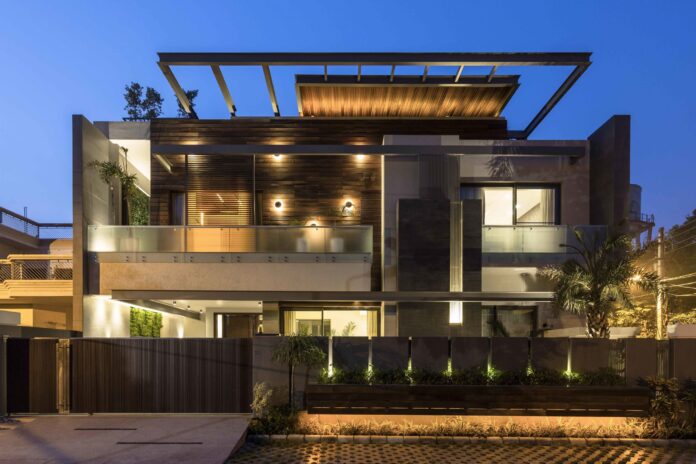
Requirement of face veneer and importance of its thickness in plywood: Current perspective
- April 10, 2023
- 0
As per BIS specifications, in construction for a plywood, thickness of any layer of veneer, must not be more than double of the thickness of veneer in the adjacent layer, to pass the test values of different tests set in IS specifications.
In India surface look of plywood keeps great importance in retail market. Consumers, with few exceptions, cannot assess the actual quality requirements for its end use. Hence beautiful surface look is the first attraction for purchase of plywood.
Usual demand for surface look are: single sheet in length and breadth of plywood, no dead knots, no split, attractive grain and colour. Such face veneer comes from high girth old grown logs which are three to four times costlier than the plantation timber used for core and panel in making plywood. To compensate the cost, the thickness of face veneer is being reduced which has come down to 0.2 to 0.3 mm and are being used to make all grades of plywood.
Use of very thin veneer as surface layer of plywood is just ornamental and has tremendous deteriorating effects on the strength properties of like glue sheer strength, tensile strength and bending properties (modulus of elasticity and modulus of rupture).
As per BIS specifications, in construction for a plywood, thickness of any layer of veneer, must not be more than double of the thickness of veneer in the adjacent layer, to pass the test values of different tests set in IS specifications.
Glue shear strength of plywood, having glue core thickness 1.8mm and face veneer thickness of 1.0mm, easily passes the GS values at ‘face – glue core’ set in BIS specifications. If the face thickness is less than 0.9mm, the GSS values come down to 9 – 25% less than the BIS prescribed limit. As the face veneer thickness becomes even less, GSS values will go down with predominant wood failure. Same things happen in case of tensile strength and bending tests (MOE and MOR).
When the face veneer thickness is 0.3mm or less, it is obvious that the total thickness of veneer (in plywood) along the face grain become less than that of veneer across the face grain. As a result, MOE and MOR values of plywood measured across the face grain becomes more than that of values along the face grain. This is just the reverse of the required values prescribed in BIS specifications.
In present days, since the thickness of the face veneer for making plywood has come down to 0.3mm or less, no laboratory measure the GSS values of glue line ‘face- glue core- panel’. Such veneer construction is utterly imbalance as per BIS specifications and the GSS values are obviously very low.
In India, plywood industry has its sole supply of timber for glue core and panel from domestic source, whereas the industry is entirely dependent on import for face veneer (either veneer or log). Face veneer is costly compared to logs for core/panel veneer and hence the thickness is being reduced to compensate the cost. Going back to increase the face veneer thickness has remote chance under present log/ veneer supply scenario in India. So the question of making plywood as per BIS specifications remains in future also.
Indian plywood market has been made to grow up in such way that it may be difficult to swipe out the concept of beautiful face for plywood. The following two solutions may be given a thought:
1 Use of thicker composed pseudo face veneer made from short length and width peeled veneer from plantation timber by composing into full length through finger/ scarf jointing and splicing of short width veneer into full width of plywood. Even defective parts of veneer can be replaced by defectless veneer of same species having matching grain through patch work. Make the mat with this pseudo face and then overlay with normal face veneer as used by the factory.
For product where high mechanical strength is required e.g., marine, shuttering and structural plywood, thicker composed face veneer (as said above) will be ideal. Technology and machinery are available in India to make such plywood.
2 The plywood industry can go ahead with skin like face veneer to achieve economy in plywood production. It is open secret that many plywood brands made with 0.3mm or less thick face veneer are marketed with BIS licence. But if the samples are tested for GSS for the glue line ‘face – glue core – panel’ will definitely fail. Also such samples will fail to meet the required values of MOE and MOR along the face grain as per BIS specifications.
Hence it is needed that BIS re-evaluate the mechanical properties of various grades of plywood made with 0.3mm or lesser thick face veneer and amend the specifications as per best values obtained for various mechanical properties. This is for the best interest of both the manufacturers and consumers.
प्लाईवुड में फेस विनियर की आवश्यकता और इसकी मोटाई का महत्व: आज का परिदृश्य
बीआईएस विनिर्देशों के अनुसार, एक प्लाईवुड के लिए विनियर की परत निर्माण में, विनियर की किसी भी परत की मोटाई, आसन्न परत में विनियर की मोटाई की दोगुनी से अधिक नहीं होनी चाहिए, ताकि आईएस विनिर्देशों में निर्धारित विभिन्न परीक्षणों के मानक मूल्यों को पास किया जा सके।
भारत में प्लाइवुड का बाह्य रूप (सरफेस लुक) खुदरा बाजार में बहुत महत्व रखता है। उपभोक्ता, कुछ अपवादों के साथ, इसके अंतिम उपयोग के लिए वास्तविक गुण दोषों का आकलन नहीं कर सकते हैं। इसलिए प्लाइवुड की खरीद के लिए सुंदर सतह का दिखना पहला आकर्षण है।
सरफेस लुक के लिए सामान्य मांग हैंः प्लाईवुड की पूरी लंबाई और चौड़ाई में सिंगल शीट, बगैर डेड नॉट के बिना फटा, आकर्षक ग्रेन और रंग। इस तरह का फेस विनियर, उच्च मोटाई वाले पुराने उगाए गए पेड़ों से आता है, जो प्लाइवुड बनाने में कोर और पैनल के लिए उपयोग किए जाने वाले प्लांटेशन टिम्बर की तुलना में तीन से चार गुना महंगा होता है। लागत की भरपाई के लिए फेस विनियर की मोटाई कम की जा रही है जो घटकर 0.2 से 0.3 मिमी रह गई है और इसका उपयोग सभी ग्रेड के प्लाईवुड बनाने में किया जा रहा है।
प्लाईवुड की सतह परत के रूप में बहुत पतले विनियर का उपयोग सिर्फ सजावटी है और उससे गोंद की सरासर ताकत (glue shear strenght) तन्य शक्ति (Tensile Strenght) और झुकने के गुणों (bending properties) (लोच के मापांक और टूटने के मापांक) जैसे ताकतवर गुणों पर जबरदस्त नुकसान देह प्रभाव होते हैं।
बीआईएस विनिर्देशों के अनुसार, एक प्लाईवुड के लिए विनियर की परत निर्माण में, विनियर की किसी भी परत की मोटाई, आसन्न परत में विनियर की मोटाई की दोगुनी से अधिक नहीं होनी चाहिए, ताकि आईएस विनिर्देशों में निर्धारित विभिन्न परीक्षणों के मानक मूल्यों को पास किया जा सके।
ग्लू कोर की मोटाई 1.8 मिमी और 1.0 मिमी की फेस विनियर मोटाई वाले प्लाइवुड की ग्लू शीयर स्ट्रेंथ आसानी से बीआईएस विनिर्देशों में सेट ’फेस-ग्लू कोर’ पर जीएस वैल्यू को उत्तीर्ण कर जाती है। यदि फेस की मोटाई 0.9 मिमी से कम है, तो जीएसएस मान 9 – बीआईएस निर्धारित सीमा से 25 प्रतिशत कम हो जाता है। जैसे-जैसे फेस विनियर की मोटाई और भी कम होती जाती है, लकड़ी की विफलता (Wood-failure) के साथ साथ जीएसएस मान नीचे चला जाएगा। टेन्साइल स्ट्रेंथ और बेंडिंग टेस्ट (MOEऔर MOR) के मामले में भी यही होता है।
जब फेस विनियर की मोटाई 0.3 मिमी या उससे कम होती है, तो यह स्पष्ट है कि फेस ग्रेन के साथ विनियर (प्लाईवुड में) की कुल मोटाई, फेस ग्रेन के आड़े विनीयर की तुलना में कम हो जाती है। नतीजतन, फेस ग्रेन के विपरीत आड़े पर मापा गया प्लाईवुड का एमओई और एमओआर मान, फेस ग्रेन के बराबर के मूल्यों से अधिक हो जाता है। यह बीआईएस विनिर्देशों में निर्धारित आवश्यक मूल्यों के बिल्कुल विपरीत है।
वर्तमान दिनों में, चूंकि प्लाईवुड बनाने के लिए फेस विनियर की मोटाई 0.3 मिमी या उससे कम हो गई है, कोई भी प्रयोगशाला ग्लू लाइन के ’फेस-ग्लू कोर-पैनल’ के जीएसएस मूल्यों को नहीं मापती है। इस तरह के विनियर परत का निर्माण बीआईएस विनिर्देशों के अनुसार पूरी तरह से असंतुलित है और जीएसएस मूल्य स्पष्ट रूप से बहुत कम हैं।
भारत में, प्लाईवुड उद्योग के पास घरेलू स्रोत से लकड़ी की एकमात्र आपूर्ति ग्लू कोर और पैनल के लिए है, जबकि उद्योग फेस विनियर (या तो विनियर या पेड़ों के लट्ठे) के लिए पूरी तरह से आयात पर निर्भर है। कोर/पैनल विनियर के लिए लॉग्स की तुलना में फेस विनियर महंगा है और इसलिए लागत की भरपाई के लिए मोटाई कम की जा रही है। भारत में वर्तमान लॉग/विनियर आपूर्ति के वर्त्तमान परिदृश्य के तहत फेस विनियर की मोटाई बढ़ाने की कोशिस दूर का सपना है। इसलिए भविष्य में भी बीआईएस विनिर्देशों के अनुसार प्लाईवुड बनाने पर प्र्रश्नचिन्ह् बना रहता है।
भारतीय प्लाइवुड बाजार को इस तरह विकसित किया गया है कि प्लाइवुड के लिए सुंदर आवरण की अवधारणा को दरकिनार करना मुश्किल हो सकता है। निम्नलिखित दो समाधानों पर विचार किया जा सकता हैः
1 मोटे समाहित ६द्म विनीयर का उपयोग किया जा सकता है, जिसे कृषि वाणिकी द्वारा प्राप्त लकड़ी को, तिकोने खांचे द्वारा जोड़े गए, पूरी लंबाई के लठ्ठों के छिलके उतार कर आवश्यक चौड़ाई का बना लिया जाए। यहां तक कि विनीयर के खराब हिस्सों को भी उसी प्रजाति के मिलते जुलते दोष रहित टुकड़ों को भर कर बदला जा सकता है। इस ६द्म विनीयर से मूल प्लाई बना कर उस पर सामान्य फेस को चिपकाया जाए।
ऐसे उत्पाद के लिए जहां उच्च यांत्रिक शक्ति की आवश्यकता होती है, उदाहरण के लिए, समुद्री, शटरिंग और संरचनात्मक प्लाईवुड, मोटा कंपोज्ड फेस विनियर (जैसा कि ऊपर कहा गया है) आदर्श होगा। ऐसी प्लाईवुड बनाने के लिए भारत में तकनीक और मशीनरी उपलब्ध हैं।
2. प्लाइवुड उद्योग प्लाइवुड उत्पादन में आर्थिक संतुलन प्राप्त करने के लिए पतले फेस विनीयर के साथ आगे भी काम करता रह सकता है। यह खुला रहस्य है कि 0.3 मिमी या उससे कम मोटे फेस विनियर से बने कई प्लाईवुड ब्रांड बीआईएस लाइसेंस के साथ विपणन किए जाते हैं। लेकिन अगर गोंद लाइन (GSS) के लिए जीएसएस के लिए परीक्षण किया जाता है तो ’फेस-ग्लू कोर-पैनल’ निश्चित रूप से विफल हो जाएगा। साथ ही ऐसे नमूने बीआईएस विनिर्देशों के अनुसार फेस ग्रेन के साथ एमओई और एमओआर के आवश्यक मूल्यों को पूरा करने में विफल होंगे।
इसलिए यह आवश्यक है कि बीआईएस 0.3 मिमी या उससे कम मोटे फेस विनियर से बने प्लाईवुड के विभिन्न ग्रेड के यांत्रिक गुणों का पुनर्मूल्यांकन करे और विभिन्न यांत्रिक गुणों के लिए प्राप्त सर्वोत्तम मूल्यों के अनुसार विनिर्देशों में संशोधन करे। यह निर्माताओं और उपभोक्ताओं दोनों के सर्वोत्तम हित के लिए है।

































































